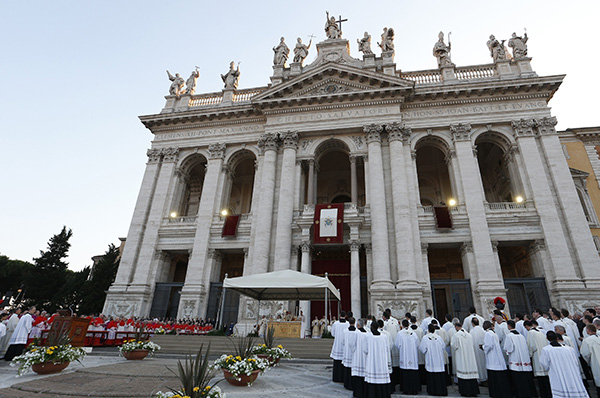
By Cindy Wooden
ROME (CNS) — A “breakdown in communication” led to permission being given to a group of Anglican clergy to celebrate the Eucharist in Rome’s Basilica of St. John Lateran, said Auxiliary Bishop Guerino Di Tora of Rome, vicar for the basilica’s chapter.
Anglican Bishop Jonathan Baker of Fulham, a suffragan bishop with responsibility for Anglo-Catholic parishes in the dioceses of London and Southwark that have requested not to be served by a woman priest or bishop, celebrated the liturgy April 18 as part of a conference in Rome for Anglo-Catholic clergy.
A statement April 20 from the Lateran Chapter said Bishop Di Tora “expresses deep regret for what happened last Tuesday, April 18, inside the Basilica of St. John in Rome. In fact, a group of about 50 priests, accompanied by their bishop, all belonging to the Anglican Communion, celebrated at the main altar of Rome’s cathedral, contravening canonical norms.”
Benedictine Father Martin Browne, an official at the Dicastery for Promoting Christian Unity, noted the apology, but said, “I also think that everyone acted in good faith and without any intent to cause offense or embarrassment to anyone else. That the celebration has caused comment is perhaps, above all else, a reminder of the need to pray continually for the Lord’s gift of unity, so that all may one day celebrate at the same altar the saving mysteries of the one Lord.”
The Vatican “Directory for the Application of Principles and Norms on Ecumenism” states that Catholic churches are “generally reserved for Catholic worship,” Father Browne said in a statement April 20.
However, he said, “it does not rule out celebrations by communities not in full communion with the Catholic Church,” although it does say that such hospitality can be offered when other Christians “do not have a place or the liturgical objects necessary for celebrating worthily their religious ceremonies.”
While the visiting Anglicans could have celebrated at the Anglican parish in the center of Rome, Father Browne said the directory also encourages “a certain ‘reciprocity’ since sharing in spiritual activities and resources, even with defined limits, is a contribution, in a spirit of mutual good will and charity, to the growth of harmony among Christians.”
“One presumes that the request was granted in that spirit of reciprocity, welcoming what was clearly an Anglican pilgrim group,” he said. In the same way, “many of the great historical cathedrals of the Church of England occasionally welcome groups from other churches, including the Catholic Church, to celebrate the Eucharist and such hospitable gestures are always appreciated.”
Still, he said, “it would have been more appropriate if this dicastery and other relevant entities of the Holy See had been involved in considering the request.”
Father Browne also clarified that “the celebration took place in the apse, which was clearly roped off, with staff on duty throughout the celebration. No members of the public nor anybody else was present or nearby,” so there was no chance that a pilgrim or tourist could have attended and thought it was a Catholic Mass.
